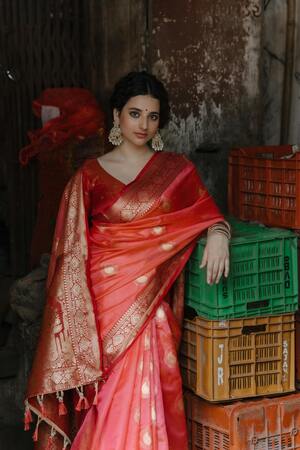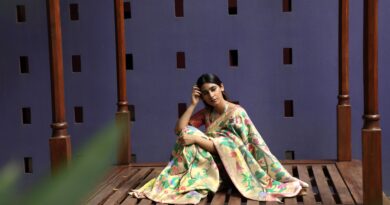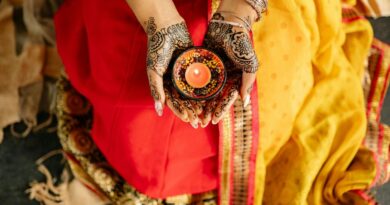Why choose a handwoven, Banarasi silk sari
From the tomato chat to the boat ride in the ghats and the piping, hot jalebis, everything in Banaras is so beautiful and artistic. My favourite from the world’s oldest city, though, is its silk. Its lightweight, smooth texture and ease its falls make it one of the most sought-after silks in the world. It also makes for great sarees that have that glamorous shine and impeccable craftsmanship. ![]()

History of Banarasi Silk
Banarasi silk traces its origins back to the ancient city of Varanasi, a cultural and artistic centre on the banks of the Ganges. Known for its vibrant textile traditions, Banaras (Varanasi) was already famous for its weaving techniques as early as the 2nd century CE. However, Banarasi silk gained unparalleled recognition during the Mughal era. The fusion of Persian designs and Indian motifs led to the creation of exquisite, intricate silk fabrics adorned with gold and silver zari work, which became synonymous with royalty and opulence.
The Mughals brought sophisticated brocade weaving techniques to India, and Banarasi weavers adapted these to craft rich and luxurious fabrics that were coveted in royal courts. Over the centuries, the Banarasi silk sari has continued to be a symbol of wealth, heritage, and tradition, often worn on special occasions like weddings and festivals, signifying timeless beauty and grandeur.
Cultural Relevance and Importance
Banarasi silk is deeply embedded in India’s cultural fabric, particularly in rituals and celebrations. The silk, which traditionally adorned kings and queens, continues to be a significant part of India’s sartorial heritage. A Banarasi sari is often passed down through generations as a family heirloom, carrying with it the stories of the women who wore it before.
This silk is also integral to bridal trousseaus. In many Indian communities, a Banarasi sari symbolizes the purity and prestige that a bride brings to her new home. Its intricate weaving represents the craftsmanship and dedication that have been honed over centuries, with designs that often carry motifs like floral and foliate patterns, kalga and bel, and scenes inspired by Mughal architecture.
Moreover, Banarasi silk has been revered for its religious significance. Priests, devotees, and pilgrims in Varanasi often choose Banarasi silk fabrics for their rituals. This further strengthens the connection between the craft and the sacred city of Varanasi, making Banarasi silk a cultural emblem that transcends fashion into spiritual and social domains.
Banarasi Silk vs. Other Silks
Banarasi silk stands apart from other types of silk due to its intricate designs, heavier texture, and the use of fine materials such as gold and silver threads for brocade work. While silks like Kanjeevaram or Mysore silk are renowned for their vibrant colours and bold patterns, Banarasi silk is unique in its ornate zari work and detailed weaving. The process of creating Banarasi silk is labour-intensive, with a single sari often taking weeks or even months to complete.
Unlike many other silks, Banarasi silk incorporates traditional Persian motifs like jaal, as well as Mughal-inspired flora and fauna, which gives it a distinct, luxurious appeal. The hand-weaving techniques have been passed down through generations of artisans, maintaining a level of craftsmanship that is unparalleled in machine-made fabrics. The density of the fabric and the richness of the embellishments make Banarasi silk one of the most luxurious silk types available in the world today.
Luxury Indian Brands Selling Hand-Woven Banarasi Silk
Several luxury Indian brands have kept the tradition of hand-woven Banarasi silk alive, offering modern designs while preserving ancient techniques. Here are a few:
-
Raw Mango – A brand that merges traditional craftsmanship with contemporary aesthetics, Raw Mango offers a range of hand-woven Banarasi saris, blending old-world charm with minimalist designs.
-
Ekaya Banaras – Known for its exquisite handloom Banarasi silk saris, Ekaya has become a go-to brand for those seeking heritage weaves with modern silhouettes. Their saris are a tribute to the artistry of Varanasi’s weavers.
-
Tilfi – This Varanasi-based brand celebrates the age-old tradition of Banarasi weaving by offering meticulously crafted saris and lehengas. Tilfi’s designs are known for their intricate craftsmanship and revival of forgotten motifs.
-
Sacred Weaves – Specializing in handloom Banarasi silk, Sacred Weaves offers a wide range of saris, shawls, and dupattas that highlight the intricate artistry of the region’s weavers.
These brands are not only committed to promoting the heritage of Banarasi silk but also work closely with artisans to ensure that these weaving techniques are passed down through generations, helping sustain their livelihoods and craftsmanship.



